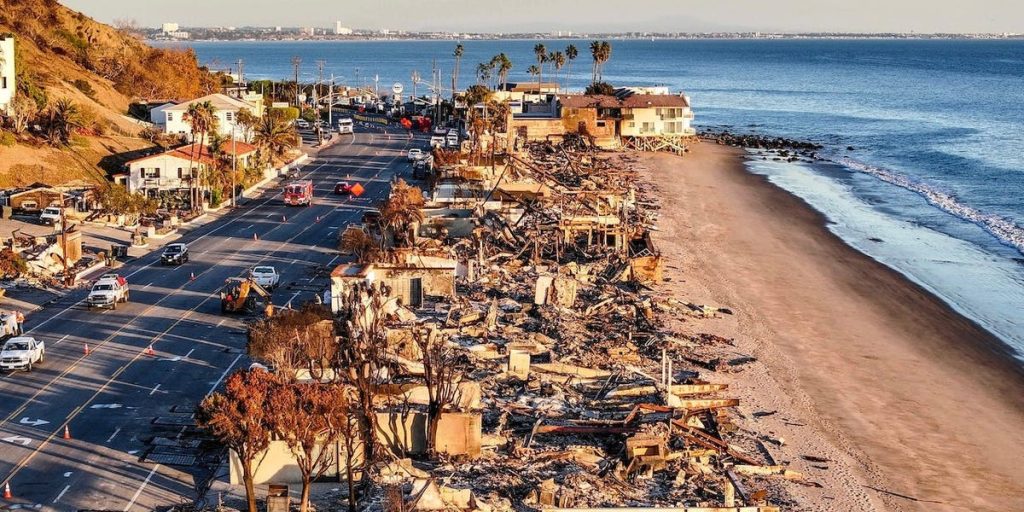The Rising Cost of Insurance in California: A Growing Challenge for Homeowners
The state of California is facing a significant challenge as State Farm, the largest home insurance provider in the state, has requested an emergency rate hike to address the financial strain caused by the recent Los Angeles wildfires. This move comes at a time when insurance affordability is already under pressure due to increasing disaster frequency and home-repair costs, which are also affecting housing affordability and long-term property values.
The Los Angeles wildfires have been particularly devastating, destroying some of the most expensive real estate in the city, including areas like Pacific Palisades and Malibu. State Farm has already handled over 8,700 claims related to these fires and has paid out approximately $1 billion as of late January. However, the company expects the total payout to be much higher, potentially making these fires the costliest in U.S. history. Analysts estimate the total damage could range between $250 billion and $275 billion, though the full financial impact won’t be clear for years as the costs are shared among local and federal governments, insurers, and residents.
State Farm has asked California regulators for permission to increase homeowners’ insurance premiums by an average of 22%, starting May 1, to avoid a "dire situation" for the company’s finances. Additionally, the company has requested a 15% increase for renters and condo owners and a 38% increase for landlords. State Farm explained that the significant payouts for wildfire claims are putting "very significant pressure" on its ability to pay out future claims. The company also emphasized that the increased risk in California, exacerbated by climate-related disasters, means that insurance costs for customers in the state will likely continue to rise.
Intensifying Home Insurance Market Instability
California has long struggled with home insurance issues, driven by the increasing costs of more frequent and intense disasters, rising home-repair costs, and inflation. Since 2022, major insurance companies like State Farm, Allstate, and Farmers Insurance have either stopped writing new policies in the state, reduced coverage, or dropped tens of thousands of property owners. This instability in the home insurance market is compounding the challenges of housing affordability and long-term property values.
State Farm stopped writing new homeowner policies in California in May 2023 and has since dropped thousands of homeowners in the state, including nearly 70% of policies in the Pacific Palisades, where the January fires caused some of the worst losses. While the nonrenewal process was recently paused in Los Angeles County due to the wildfires, State Farm still holds over 1 million homeowner policies in California. The company has faced significant financial strain over the past nine years, paying out $1.26 in claims and expenses for every $1 collected in premiums, resulting in after-tax net losses totaling $2.8 billion. The LA wildfires have further weakened State Farm’s financial position, prompting the urgent rate hike request.
State regulators approved Allstate’s request for a 34% average increase in home insurance premiums in August, and State Farm is currently awaiting approval for a 30% rate increase for homeowner policies filed in June. This would come on top of previous rate hikes approved in 2023, including a 6.9% increase in January and a 20% increase in March. The rising costs of insurance are not only affecting homeowners but also renters and landlords, as the financial burden trickles down through the housing market.
Ripple Effects on Housing Affordability Across the Country
The rising cost of insurance and the growing number of policy nonrenewals by private insurers are exacerbating housing affordability issues nationwide. A Senate Budget Committee investigation found that private insurers’ nonrenewals spiked threefold in over 200 counties between 2018 and 2023. Homeowners who are denied private insurance often have no choice but to opt for their state’s insurer of last resort, which typically offers more limited coverage at higher premiums. This shift to more expensive and less comprehensive insurance options is further straining household budgets.
The impact of rising insurance costs is being felt by both homeowners and prospective homebuyers, as well as renters who face increased costs passed on by their landlords. For many retired homeowners and individuals on fixed incomes, rising premiums are becoming unsustainable, especially when combined with increasing property taxes. In some cases, these combined costs exceed mortgage payments, creating a perfect storm of financial stress. The situation is particularly dire in areas most vulnerable to extreme weather events, where insurance premiums are spiking due to heightened risk.
The Long-Term Impact on Property Values
The combination of rising home insurance premiums and decreasing demand in climate-vulnerable areas is expected to have a profound long-term impact on property values. A recent study by the research firm First Street found that by 2055, rising insurance costs and declining demand could erase nearly $1.5 trillion in U.S. real estate values. Approximately 40% of these losses are expected to occur in what the firm calls "climate abandonment areas," where the risk of extreme weather events is so high that it leads to significant out-migration and spikes in insurance costs.
This trend is particularly concerning given that Americans are increasingly moving into parts of the country most prone to extreme weather, rather than away from them. In 2023, Redfin reported that tens of thousands more people moved into flood- and fire-prone areas than left them. This migration pattern, combined with the rising costs of insurance, paints a worrying picture for the future of housing markets in vulnerable regions.
National Implications of the Insurance Crisis
The crisis in California’s home insurance market is part of a larger national trend, with many states grappling with the consequences of climate-driven disasters and rising insurance costs. The increasing frequency and severity of events like wildfires, hurricanes, and floods are putting immense pressure on insurance companies, leading to higher premiums, reduced coverage, and policy nonrenewals. This, in turn, is affecting housing affordability and long-term property values across the country.
As the nation continues to experience more frequent and intense climate-related disasters, the insurance industry is being forced to adapt to a new reality. However, the cost of these adjustments is being passed on to consumers, creating a financial burden that is particularly challenging for low- and middle-income households. The situation in California serves as a stark reminder of the broader challenges facing the U.S. housing market and the need for systemic solutions to address the growing risks posed by climate change.
Conclusion
The recent request by State Farm to hike insurance premiums in California highlights the growing challenges faced by homeowners in the state and across the country. The combination of more frequent and intense disasters, rising home-repair costs, and inflation is creating a perfect storm that is driving up insurance costs and exacerbating housing affordability issues. The long-term implications for property values and the broader housing market are significant, with millions of Americans facing increased financial strain as they struggle to secure affordable and reliable insurance coverage. As the nation continues to grapple with the impacts of climate change, finding sustainable solutions to these challenges will be critical to ensuring the stability of the housing market and the financial well-being of homeowners and renters alike.












